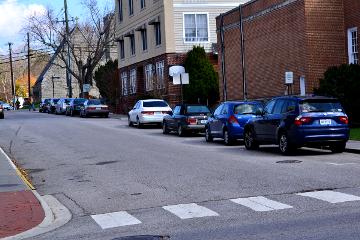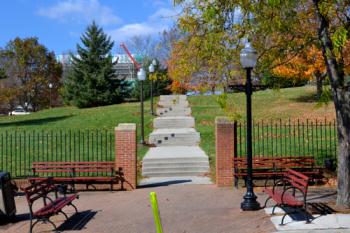 In our previous analysis of beneficial planning aspects in College Towns we noted the retention of a Mainstreet with a sense of place and proximity land use where transportation demands are reduced by locating buildings with altering uses close enough for residents to primarily walk. Blacksburg’s implementation of better land use allows a shuffle of 50,000 residents, employees, and students daily. Even with this significant population the town needs no more than two lane roads, with a minimal usage of four lane roads. No rail is necessary as much of the town and campus is walkable, but those areas that are not have consistent and unimpeded bus systems.
In our previous analysis of beneficial planning aspects in College Towns we noted the retention of a Mainstreet with a sense of place and proximity land use where transportation demands are reduced by locating buildings with altering uses close enough for residents to primarily walk. Blacksburg’s implementation of better land use allows a shuffle of 50,000 residents, employees, and students daily. Even with this significant population the town needs no more than two lane roads, with a minimal usage of four lane roads. No rail is necessary as much of the town and campus is walkable, but those areas that are not have consistent and unimpeded bus systems.
People are able to move around without the absolute need for vehicles in Blacksburg. Roads and parking remain minimal and do not take up much space in the town. So what do they do with the rest of the space? That is where the community and sense of place comes in.

Without the need to worry about parking first, regions of the town are liberated from massive infrastructure needs. Finding a net-zero cost model for bringing aesthetic benefit to Mainstreet is possible via affordable paid parking.
Critics will now scream “no one will want to pay to park and businesses will suffer”. No one said to charge an arm and a leg, and when the majority of your residents can reach Mainstreet without the need for parking the benefit of having free spaces is outweighed by the amenities that can be created from paid spaces.

In Blacksburg it is essentially impossible to find a free parking space anywhere in the vicinity of downtown, but if you do need to park down there you will find that a quarter is capable of providing enough funds for 95% of errands. Such a small amount of funds can’t do much good though. False. The fact is that niceties of public space like benches, farmers market canopies, and sustainable plantings cost thousands and last years without major upkeep.
A single paid parking space on the order of 50 cents per hour, averaging usage 1/3 of the time (8 hours per day) creates about $1500 per year. That is enough to support the cost of a decorative bench, associated landscape, and upgraded pedestrian pavement. It creates a sense of place for a downtown and becomes an attractant for people to come and be customers of downtown businesses. All of this can happen without public general funds, a source which is far more difficult to wrangle money away from for beautification projects.
 Bunch a few parking spaces together, lets say ten paid spaces, or $15,000 per year. That is enough funding to support the construction and upkeep of decorative canopies which can act as gathering areas for community events or even better stations for farmer’s markets (which can subsequently be charged a small fee for setting up a booth under).
Bunch a few parking spaces together, lets say ten paid spaces, or $15,000 per year. That is enough funding to support the construction and upkeep of decorative canopies which can act as gathering areas for community events or even better stations for farmer’s markets (which can subsequently be charged a small fee for setting up a booth under).
When you stop focusing on appeasing the gods of single occupancy traffic, and more importantly parking, you free yourself to an endless world of possibilities. You can implement tried and true planning practices that are more in line with the golden age of the small town and a far healthier world for small businesses. It is no surprise towns which destroy a downtown and Mainstreet for the sake of improving traffic flow are often the same that become the most victimized from large national chains and big box stores which not only decimate small businesses but funnel wealth from within the community to outside of the town.
 During America’s greatest periods of small retail growth (1940s-1950s) one dynamic held true, the retention of a main street. The era of strip malls and parking lots has echoed that of big box stores and the death of mom and pop stores. There is a reason for this. Without the benefit of atmosphere and convenience big box stores continue to draw away consumers for cheap prices.
During America’s greatest periods of small retail growth (1940s-1950s) one dynamic held true, the retention of a main street. The era of strip malls and parking lots has echoed that of big box stores and the death of mom and pop stores. There is a reason for this. Without the benefit of atmosphere and convenience big box stores continue to draw away consumers for cheap prices.
Unfortunately, with so much that can be learned from small towns like Blacksburg, the influence of suburban design is beginning to be felt. Recently two new massive parking garages have been constructed in and around downtown for students and for main street. The new garages will pacify those who complain about parking difficulties of waiting for a space to be free, but will also discourage the use of the high quality transit system, bike accessibility, and good old-fashioned walking. Ultimately what is lost will be places to gather and the sense of community.
